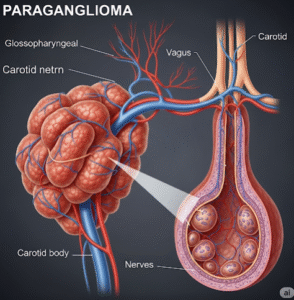Overview
Acute Intermittent Porphyria (AIP) is a rare, inherited metabolic disorder that affects the production of heme, a crucial component of hemoglobin. It belongs to a group of conditions called porphyrias, which result from enzyme deficiencies in the heme biosynthesis pathway. AIP primarily impacts the nervous system and causes sudden, severe episodes of abdominal, neurological, and psychiatric symptoms.
Attacks can be life-threatening if untreated, but with proper management and avoidance of triggers, individuals can live relatively normal lives.
What is Acute Intermittent Porphyria?
Acute Intermittent Porphyria is a genetic disorder caused by a deficiency of the enzyme porphobilinogen deaminase (also called hydroxymethylbilane synthase). This enzyme is essential in the heme production process. When it’s deficient, toxic substances build up in the liver and bloodstream, leading to acute neurovisceral attacks.
AIP typically presents after puberty, more often in females, and attacks can be triggered by factors such as medications, hormonal changes, stress, or fasting.
Symptoms
AIP symptoms occur during acute attacks and vary in intensity. Common symptoms include:
- Severe abdominal pain (without physical signs on examination)
- Nausea and vomiting
- Constipation
- Muscle weakness
- Back and limb pain
- Dark or reddish urine
- Tachycardia (rapid heartbeat)
- High blood pressure
- Confusion, anxiety, or hallucinations
- Seizures
- Paralysis (in severe cases)
Symptoms may last for several days or weeks and often require hospitalization.
Causes
AIP is caused by mutations in the HMBS gene, which encodes the enzyme porphobilinogen deaminase. It is inherited in an autosomal dominant pattern, meaning only one mutated gene copy is needed to be affected.
However, not all gene carriers experience symptoms—attacks are typically triggered by external factors that increase heme demand or interfere with heme synthesis, such as:
- Certain medications (e.g., barbiturates, sulfa drugs)
- Hormonal changes (e.g., during menstruation)
- Fasting or dieting
- Alcohol use
- Infections or stress
- Smoking
Risk Factors
Individuals are at higher risk for AIP attacks if they have:
- A family history of porphyria
- Female gender (especially post-puberty)
- Hormonal fluctuations (e.g., during menstruation)
- Use of unsafe medications or recreational drugs
- History of crash dieting or fasting
- Liver disease
Complications
If not diagnosed and managed promptly, AIP can lead to severe complications:
- Chronic hypertension
- Kidney damage or failure
- Liver damage or hepatocellular carcinoma (liver cancer)
- Respiratory failure due to muscle paralysis
- Permanent nerve damage
- Severe mental health issues during attacks
- Death, in untreated severe cases
Prevention
There is no cure for AIP, but attacks can be significantly reduced or avoided with these preventive strategies:
- Avoid known trigger medications (maintain a list of safe/unsafe drugs)
- Avoid fasting and extreme dieting
- Limit alcohol consumption
- Avoid smoking
- Manage hormonal fluctuations (especially in women with frequent attacks)
- Reduce stress and get regular medical follow-ups
- Genetic counseling for family members
Treatment Options Korea
1. Hospital Admission
- Required during acute attacks due to risk of severe abdominal pain, seizures, or paralysis
- Close monitoring in neurology or internal medicine wards
2. Intravenous Hemin Therapy
- First-line treatment to reduce porphyrin precursor production
- Hemin for injection (e.g., Panhematin or Normosang) may be available through special access programs in Korea
- Administered IV for 3–4 days during acute attacks
3. Glucose Infusion
- High-dose IV glucose (10–20%) used if hemin is unavailable or in mild cases
- Helps suppress hepatic ALA synthase activity to reduce toxin buildup
4. Symptomatic Management
- Pain control with opioids (avoiding porphyrin-inducing drugs)
- Anti-nausea and anti-anxiety medications (only porphyria-safe options)
- Seizure control with porphyria-compatible anticonvulsants (e.g., gabapentin)
5. Avoidance of Triggers
- Eliminate known inducers: certain medications, fasting, alcohol, infections, stress, hormonal changes
- Patient education and medication alert cards recommended
6. Genetic Counseling and Long-Term Care
- AIP is an autosomal dominant disorder
- Family screening and genetic counseling offered at major Korean medical centers
- Long-term care includes monitoring kidney function, liver health, and psychological support
Final Thoughts
Acute Intermittent Porphyria is a rare but potentially severe condition. With proper diagnosis, awareness of triggers, and access to specialized care, individuals can effectively manage the disease and reduce the frequency and severity of attacks. Early recognition and genetic screening in families can also help prevent life-threatening complications.













